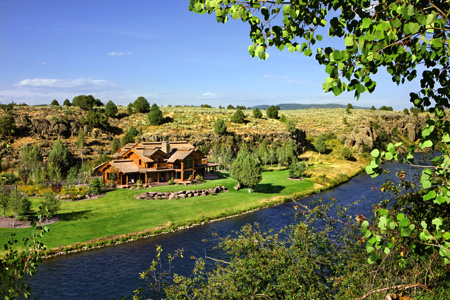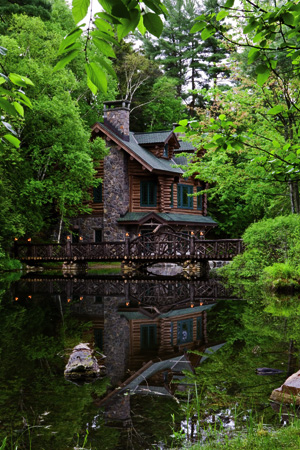When Rob Wrightman sits down to talk with clients about designing and building a new, waterfront log home, one of his first tasks is to explain how such abodes have more than one “face.” Whereas a log home in a more traditional setting usually has one showcase side for passers-by to admire and comment on, the waterfront log home has at least two.
“This is a very important point when building on the water,” says Wrightman, CEO at Bracebridge, Ontario-based True North Log Homes, Inc. “Our goal is to make the property attractive for someone who is driving up to the log home, as well as someone who is motoring or sailing up to it.”
With about 80 percent of his firm’s homes situated on the water, Wrightman has become somewhat of an expert at helping owners understand the need for multiple “faces,” and he incorporates that philosophy into the design and building phases.
“Trying to maintain the aesthetics and beauty of a waterfront log home requires some creativity,” says Wrightman, “namely because we’re dealing with two different elevations [since most waterfront homes are built on slopes] while striving to maintain the beauty and aesthetics across multiple faces.”
Inside the homes, True North uses a combination of wide-entrance systems, great rooms situated just off of those entrances, and glass to create “wow” factors and maximize the panoramic views. “People pay a lot of money for waterfront properties,” says Wrightman, “so we try to try to capture as much of the view as possible.”
First Things First
From early design tweaks to construction to long-term maintenance considerations, log home owners who build on streams, rivers, lakes, and oceans face some unique challenges, but also have opportunities that their land-locked brethren don’t have.
Consider the fact that most waterfront homes are built on slopes that lead down to the body of water, for example. Wrightman says homeowners on any terrain address the issue by incorporating walk-out basements into the design of the foundation. Then, they can use elements such as decks and stairs to create a more aesthetically appealing “face” on that particular side of the home.
“Particularly if we’re dealing with steep slopes, we can drop the deck down a couple of steps right near the front door,” says Wrightman, “so the walk-out basement becomes a thing of beauty, instead of an obstruction.”
Creating a Masterpiece
When building on the water, it’s all about the view. To help homeowners maximize their investment, Chris Webster, marketing manager at Heritage Log Homes in Kodak, Tennessee, says his firm incorporates conventionally framed walls into its waterfront log home designs. “That allows us to install more windows,” says Webster, “so that the homeowners can enjoy their surroundings.”
Webster says homeowners should also contemplate cedar shakes, live-edge siding, and other elements that will help their log homes blend into the surrounding environment. Size also comes into consideration, he says, as fewer owners take the McMansion route, and more opt for “log homes that are of moderate size, and look like they organically grew out of the environment.”
And speaking of the environment, it also comes into play when building on the water. According to Webster, environment even dictates the size and shape of the logs used during construction. In wooded, lake areas, for example, builders will usually use large, round logs that are stained a natural, dark color. In oceanfront communities, Webster says 6 X 12 logs with coastal corners (dovetailed, flush corners) are most popular, due to their versatility and ability to “blend” with traditional, oceanfront homes.
Ehren Graf, national home consultant with Green Bay, Wisconsin-based Wisconsin Log Homes, says floorplans are an important consideration when building on the water, and advises homeowners to work closely with their designers to achieve the desired results. “Prioritize your needs and verbalize your budget right from the start,” Graf advises. “You want a floorplan that accommodates your lifestyle, while also blending in naturally with the home’s surroundings.”
Long-Term View
A lot of people assume that building on the water equates to higher maintenance costs, but Webster says that perception is false. In fact, he says log homes are an especially good choice for someone who is looking for low-hassle waterfront living. “The logs themselves can handle the high humidity associated with waterfront dwelling,” says Webster, “and tend to not only keep the interior dry and cozy, but also don’t harbor mold like traditionally-constructed walls do.”
To keep a waterfront log home looking fresh and new, Webster suggests staining the exterior every three to five years, depending on sun exposure and other elements, such as wind. Always use water-based stains over oil-based options, he adds, to avoid introducing toxic chemicals into the nearby waterway. “Think ‘green’ when you’re designing, building and maintaining your log home,” says Webster, “and make it a natural part of the waterfront environment.”


